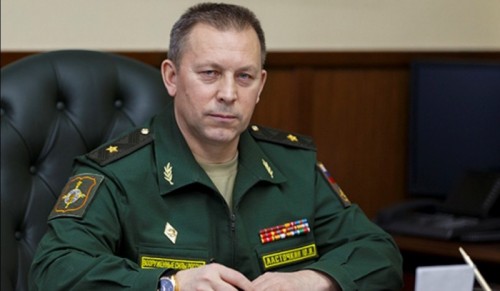Russia’s Chief of EW Troops, General-Major Yuriy Lastochkin gave an interview to Krasnaya zvezda in April for the Day of the Electronic Warfare Specialist. His remarks make interesting reading on the direction of Russian EW. The interview was subsequently carried by other media outlets, most recently by VPK.

General-Major Lastochkin
Asked what areas of EW are most critical today, Lastochkin replied:
“The introduction of modern electronic technologies in the command and control systems of forces and means of the armed forces of leading foreign countries is a component part of realizing the prompt global strike concept. This, adopted in the U.S. Armed Forces as a Doctrine of conducting combat actions in a unified information space, substantially increases the level of threat to the military security of the Russian Federation, and fundamentally changes the character and content of armed struggle.”
“The increase in the role of EW is determined by the very mission of disorganizing the command and control of enemy troops and weapons by means of electronic defeat. We have to recognize distinctly that a new realm of confrontation has appeared — the information-telecommunications space. The spectrum of missions of EW Troops is broadening significantly. The effect of using developmental EW means is comparable to defeat by precision fire. Conceptual documents approved by the RF President in the realm of electronic warfare aim for this. The country’s military-political leadership attaches great significance to the improvement of EW systems as one of the most important elements of guaranteeing national security. Today electronic warfare is a most complex intellectual-technical component, particularly in hybrid conflicts. This in turn requires the development of principally new means capable of neutralizing the enemy’s technological and information advantage.”
The chief described Russia’s EW forces:
“Our troops are designated for the electronic defeat of enemy targets and systematic control of measures to counter technical reconnaissance means, and electronic defense of our own troops. They consist of command and control organs, formations [brigades], military units [regiments] and sub-units [battalions, companies] of various subordination. EW forces and means are part of the strategic system of radio jamming, the Unified System of Systematic Technical Control (KTK¹), and the array of EW units of military districts, large formations [armies] and formations [divisions, brigades] of the services and branches of the RF Armed Forces.”
“At present, the main forces and means are concentrated in the Ground Troops, Aerospace Forces and Navy, and the component inter-service groupings of military districts. In the VDV, we’ve established EW sub-units in assault divisions. In the RVSN, there are KTK sub-units for every missile army, division, and testing ground. Since 2014, the forces and means of radio jamming in the districts have carried out duty missions.”
What the priority directions for development of EW systems?
“The improvement of EW equipment needs to be balanced. There is a traditional approach. It suggests broadening the list of targets countered, cutting the types of EW means, unification, increasing protection against precision weapons, mobility and modernization potential. In the innovation plan, I would single out five directions:
- deployment of controlled fields of radio suppression on enemy territory on the basis of unified small dimension reconnaissance and jamming modules delivered by UAVs;
- creation of defeat means with powerful electromagnetic radiation on the basis of the employment of specialized munitions and mobile systems;
- development of programmable equipment for action on highly-organized command and control systems by destroying the accessibility, integrity, and confidentiality of information;
- introduction of means of imitating a false electronic situation and disinforming the enemy’s system of troop command and control and weaponry;
- increasing the level of information security of organs (points) of EW command and control, improving decisionmaking support algorithms through the unified circuit of command and control of forces and means.”
Lastochkin mentioned that Zaslon-REB [Barrier-EW] entered state acceptance testing last year. It seems to be some kind of COMSEC system designed to “block all possible channels for leaking confidential information and establish an ‘impenetrable information dome’ over Russian Defense Ministry facilities.”
Russian EW exercises, he said, have doubled during the past four years. “Electron-2016” exercise was the first strategic level drill for EW Troops since 1979. They used this training to experiment with new equipment, and develop procedures and tactics.
Asked about countering enemy UAVs, Lastochkin said EW is the only effective means against small unmanned aircraft.
He indicated that a “situation center” has been established in the Directorate of the Chief of EW Troops. It links EW formations [brigades] to their units in the field. He looks forward to a system that presents Russia’s operational and electronic situation in a “single information space.”
Lastochkin claimed Western sanctions have had only a minimal effect on equipping Russia’s EW units, and he expects to have 70 percent modern systems by 2020. Besides Sozvezdiye and KRET, STTs — a UAV developer — works closely with the EW Troops, according to their chief.
He told his interviewer that the EW Troops have tested 30 different types of equipment during the past three years. He intends to make “serious investments in modernizing the experimental-testing base.”
In conclusion, General-Major Lastochkin summarized the goal of Russian EW:
“The entire system of measures of organizational development of EW Troops will substantially increase their contribution to winning superiority in command and control, and in employing weapons. The volume of effectively fulfilled missions in various strategic directions will grow by two – two and a half times and by 2020 will reach 85 percent. This in turn will become the basis of an effective air-ground EW system, capable of neutralizing the enemy’s technological advantage in the aerospace sphere and the information-telecommunications space.”
__________________________
¹KTK appears to be analogous to electronic support, i.e. “actions tasked by, or under direct control of, an operational commander to search for, intercept, identify, and locate or localize sources of intentional and unintentional radiated electromagnetic energy for the purpose of immediate threat recognition, targeting, planning, and conduct of future operations,” to quote Joint Pub 3-13.1 Electronic Warfare.





